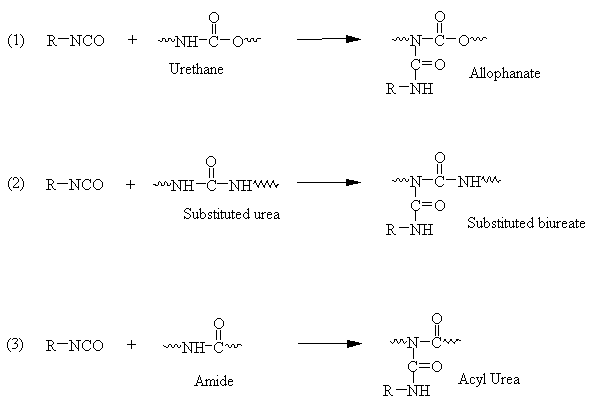Polyurethanes
Polyurethanes (PU) are the polymers containing significant number of urethane groups (–NH-CO-O-) in the molecular chain. The most common method of preparing polyurethane is condensation reaction of a diisocyanate and a polyol. Unlike conventional polycondensation, this polymerisation reaction does not eliminate any by-product.

The structure of polyurethane can be complex and diverse containing "hard" and "soft" segments, which contribute to the balance between rigid and elastomeric properties. Polyurethanes are synthesised by two methods namely, prepolymer method and one- shot method. In prepolymer method, the polyisocyanate and polyol are reacted to form an intermediate polymer called "prepolymer". It is then converted into final high molecular weight polymer by further reaction with diol or diamine chain extender. In the 'one-shot' method, the polymer formation is carried out by simultaneous reaction of polyol, polyisocyanate and chain extender.
Raw Materials
Isocyanates:
Isocyanates are commercially prepared by phosgenation of primary amines. Toluene diisocyanate, diphenyl methane diisocyanate, hexamethylene diisocyanate, xylene diisocyanate and isophorone diisocyanate are the most widely used isocyanates in polyurethane synthesis. Aromatic isocyanates are more reactive than aliphatic ones.
Polyols:
The most widely used polyhydroxy compounds, commonly known as polyols, in polyurethane synthesis are hydroxyl-terminated polyether and polyester, polyolefins and glycols. The properties of the polyurethane mainly depend upon the type of polyol used for its synthesis. Generally, long chain, high molecular weight polyols are used in elastomer synthesis.
Reactions of Isocyanates
The isocyanate group (-N=C=O) is a highly unsaturated and extremely reactive group, containing two cumulative double bonds. It can react with both electron donor and electron acceptor functional groups. The most important groups that react with isocyanates are amino, hydroxyl and carboxyl groups. Isocyanates undergoes two types of reactions, namely primary and secondary reactions described as follow,
(A) Primary reactions:
Primary reactions are relatively faster and occur at relatively lower temperatures compared to the secondary reactions. The various primary reactions of isocyanates shown in Figure 2.8 are described as follow.
Isocyanate reacts with hydroxyl group as shown in Figure A (1) to produce urethane linkage. This reaction is exothermic. Isocyanates reacts readily with primary hydroxyl groups than secondary ones. Isocyanates reacts with amino groups at 0-25oC to form substituted urea as shown in Figure A (2). Primary amino groups have higher reactivity with isocyanate than secondary ones. Reaction of isocyanate with carboxylic acid shown in Figure A (3) leads to the formation of amide linkage, which is similar to urethane linkage. This reaction produces carbon dioxide gas.

Figure A: Primary reactions
Isocyanates readily reacts with water to produce amines and carbon dioxide gas [Figure A (4)]. The evolved carbon dioxide gas causes foaming and is undesirable in synthesis of polyurethane elastomers. Therefore all the reactants and apparatus used in polyurethane synthesis needs to be dried thoroughly.
(B) Secondary reactions:
Isocyanates react with the secondary amino group of urethanes, ureas, and amide forming allophanates, substituted biurets, and acyl ureas respectively as shown in Figure B. The secondary reactions of isocyanate leads to cross-linking, and the resulting polyurethane becomes insoluble and infusible. Thus the temperature control during polyurethane synthesis is critical to avoid secondary reactions and thereby cross-linking.

Figure B: Secondary reactions
Isocyanate readily undergoes dimerisation and trimerisation to form uretidinediones and isocyanurates respectively. The trimerisation reaction as shown below occurs in presence of catalysts such as, metal oxide, tertiary amines and amides.

The isocyanurate, which is a six-member ring is thermally most stable and enhances fire resistance of the polymer. However, it increases the functionality of the system, which forms a crosslinked network, which is undesirable in the present study.
The isocyanate also reacts with epoxide group to form oxazolidone linkage as shown below . Oxazolidone is a saturated, five-member heterocyclic group. This cyclic structure is very stiff which imparts rigidity and excellent thermal properties to the polymer. Isocyanurate and oxazolidone formation have been studied extensively.

This reaction occurs only at high temperature i.e. above 200oC. Thus the formation of oxazolidone can be controlled by proper selection of temperature.